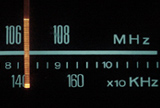mixed numbers:
The hidden meaning
of everyday digits
AM & FM Radio Callsigns

When we listen to the radio, we experience a constant barrage of the frequency and call letters of the station to which we're listing. For the radio station, this means that we are likely to remember this information and will tune in whenever we can and also tell our friends. While they are primarily used by the general public as such, the true purpose of these numbers and letters is not just for the sake of listener memory and advertising rates.
In fact, the radio dial provides the average person considerable insight into the nature of signal transmission. Consumer radios provide the listener with a choice between two ranges of numbers, AM and FM. FM usually sounds better and has more commercially sophisticated programming. AM is less clear and usual deals primarily with talk programs. The cause of these differences are clear through a more in-depth comparison:
- AM stands for amplitude modulation, and is measured in kilohertz(kHz). AM stations can be located, every 10 kHz, between 535 and 1705 kHz.
- FM stands for frequency modulation, and is measured in megahertz (MHz). FM stations can be located between 88 and 108 MHz, but unlike AM, FM stations aren't restricted to whole number frequencies.
It's no coincidence "K" is at the beginning of every set of call letters in Austin. As stated in Thomas White's explanation of U.S. Call Letter Policies, the first letter of a station's call letters refers to the side of the Mississippi River the station is located, "K" for west, and "W" for east.
These standards were officially applied in 1923, based on classifications for radio stations on ships on either coast. Stations in either region with the opposite's first letter were allowed to retain their original call letters, and some of those still exist today.
For More Information:
© Patrick Williams 2003-2004
xhtml | CSS | 508